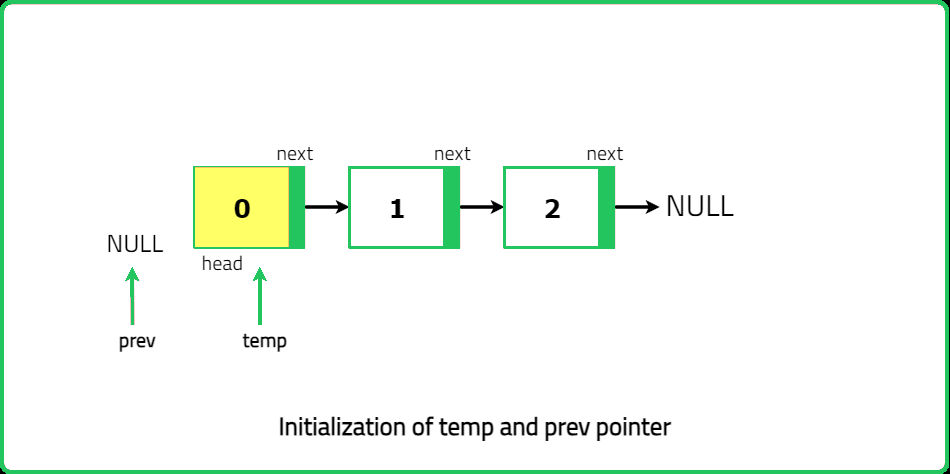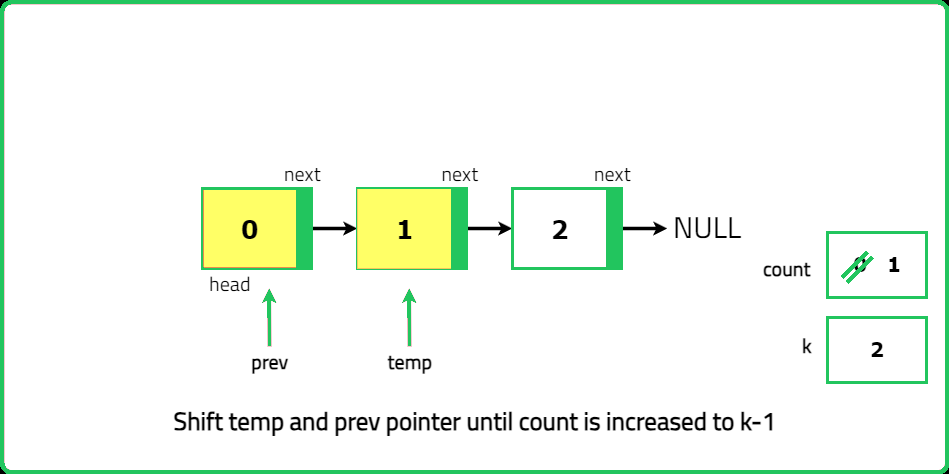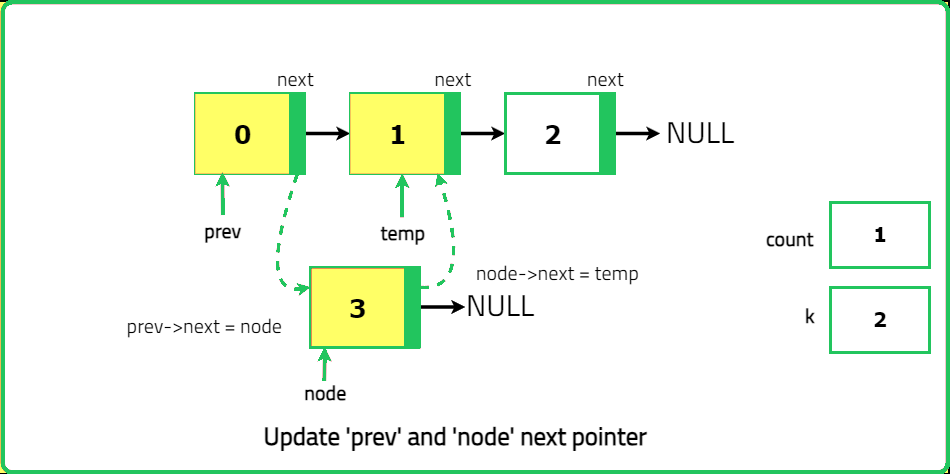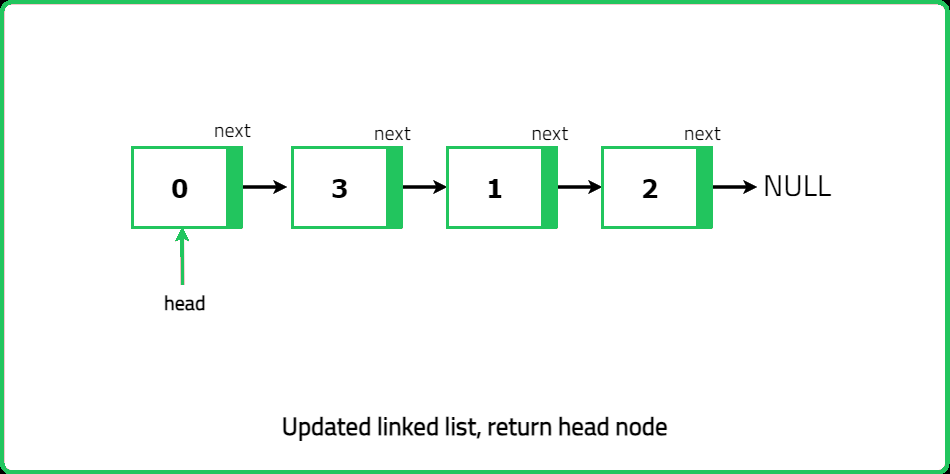123456789101112131415161718192021222324252627282930313233343536373839404142434445464748495051525354555657585960616263646566676869707172737475767778798081828384858687888990919293
#include <bits/stdc++.h>
using namespace std;
// Definition of singly linked list
struct ListNode
{
int val;
ListNode *next;
ListNode(int data1)
{
val = data1;
next = NULL;
}
ListNode(int data1, ListNode *next1)
{
val = data1;
next = next1;
}
};
// Solution class
class Solution {
public:
// Function to insert a new node at the kth position
ListNode* insertAtKthPosition(ListNode* &head, int X, int K) {
/* If the linked list is empty
and k is 1, insert the
new node as the head*/
if (head == NULL) {
if (K == 1)
return new ListNode(X);
else
return head;
}
/*If K is 1, insert the new
node at the beginning
of the linked list*/
if (K == 1)
return new ListNode(X, head);
int cnt = 0;
ListNode* temp = head;
/* Traverse the linked list
to find the node at position k-1*/
while (temp != NULL) {
cnt++;
if (cnt == K-1) {
/* Insert the new node after the node
at position k-1*/
ListNode* newNode = new ListNode(X, temp->next);
temp->next = newNode;
break;
}
temp = temp->next;
}
return head;
}
};
// Helper Function to print the linked list
void printLL(ListNode* head) {
while (head != NULL) {
cout << head->val << " ";
head = head->next;
}
cout << endl;
}
int main() {
// Create a linked list from a vector
vector<int> arr = {10, 30, 40};
int X = 20, K = 2;
ListNode* head = new ListNode(arr[0]);
head->next = new ListNode(arr[1]);
head->next->next = new ListNode(arr[2]);
// Print the original list
cout << "Original List: ";
printLL(head);
// Create a Solution object
Solution sol;
head = sol.insertAtKthPosition(head, X, K);
// Print the modified linked list
cout << "List after inserting the given value at the Kth position: ";
printLL(head);
return 0;
}
1234567891011121314151617181920212223242526272829303132333435363738394041424344454647484950515253545556575859606162636465666768697071727374757677787980818283848586878889909192
import java.util.*;
// Definition of singly linked list
class ListNode {
int val;
ListNode next;
ListNode(int data1) {
val = data1;
next = null;
}
ListNode(int data1, ListNode next1) {
val = data1;
next = next1;
}
}
// Solution class
class Solution {
// Function to insert a new node at the kth position
public ListNode insertAtKthPosition(ListNode head, int X, int K) {
/* If the linked list is empty
and k is 1, insert the
new node as the head */
if (head == null) {
if (K == 1)
return new ListNode(X);
else
return head;
}
/* If K is 1, insert the new
node at the beginning
of the linked list */
if (K == 1)
return new ListNode(X, head);
int cnt = 0;
ListNode temp = head;
/* Traverse the linked list
to find the node at position k-1 */
while (temp != null) {
cnt++;
if (cnt == K - 1) {
/* Insert the new node after the node
at position k-1 */
ListNode newNode = new ListNode(X, temp.next);
temp.next = newNode;
break;
}
temp = temp.next;
}
return head;
}
}
// Main class
class Main {
// Helper Method to print the linked list
private static void printLL(ListNode head) {
while (head != null) {
System.out.print(head.val + " ");
head = head.next;
}
System.out.println();
}
// main method
public static void main(String[] args) {
// Create a linked list from an array
int[] arr = {10, 30, 40};
int X = 20, K = 2;
ListNode head = new ListNode(arr[0]);
head.next = new ListNode(arr[1]);
head.next.next = new ListNode(arr[2]);
// Print the original list
System.out.print("Original List: ");
printLL(head);
// Create a Solution object
Solution sol = new Solution();
head = sol.insertAtKthPosition(head, X, K);
// Print the modified linked list
System.out.print("List after inserting the given value at the Kth position: ");
printLL(head);
}
}
1234567891011121314151617181920212223242526272829303132333435363738394041424344454647484950515253545556575859606162636465666768
# Definition of singly linked list
class ListNode:
def __init__(self, val=0, next=None):
self.val = val
self.next = next
class Solution:
# Function to insert a new node at the kth position
def insertAtKthPosition(self, head, X, K):
''' If the linked list is empty
and k is 1, insert the
new node as the head '''
if head is None:
if K == 1:
return ListNode(X)
else:
return head
''' If K is 1, insert the new
node at the beginning
of the linked list '''
if K == 1:
return ListNode(X, head)
cnt = 0
temp = head
''' Traverse the linked list
to find the node at position k-1 '''
while temp is not None:
cnt += 1
if cnt == K - 1:
''' Insert the new node after the node
at position k-1 '''
newNode = ListNode(X, temp.next)
temp.next = newNode
break
temp = temp.next
return head
# Helper Function to print the linked list
def printLL(head):
while head is not None:
print(head.val, end=" ")
head = head.next
print()
if __name__ == "__main__":
# Create a linked list from a list
arr = [10, 30, 40]
X = 20
K = 2
head = ListNode(arr[0])
head.next = ListNode(arr[1])
head.next.next = ListNode(arr[2])
# Print the original list
print("Original List: ", end="")
printLL(head)
# Create a Solution object
sol = Solution()
head = sol.insertAtKthPosition(head, X, K)
# Print the modified linked list
print("List after inserting the given value at the Kth position: ", end="")
printLL(head)
1234567891011121314151617181920212223242526272829303132333435363738394041424344454647484950515253545556575859606162636465666768697071727374757677
// Definition of singly linked list
class ListNode {
constructor(val = 0, next = null) {
this.val = val;
this.next = next;
}
}
// Solution class
class Solution {
// Function to insert a new node at the kth position
insertAtKthPosition(head, X, K) {
/* If the linked list is empty
and k is 1, insert the
new node as the head */
if (head === null) {
if (K === 1)
return new ListNode(X);
else
return head;
}
/* If K is 1, insert the new
node at the beginning
of the linked list */
if (K === 1)
return new ListNode(X, head);
let cnt = 0;
let temp = head;
/* Traverse the linked list
to find the node at position k-1 */
while (temp !== null) {
cnt++;
if (cnt === K - 1) {
/* Insert the new node after the node
at position k-1 */
let newNode = new ListNode(X, temp.next);
temp.next = newNode;
break;
}
temp = temp.next;
}
return head;
}
}
// Helper Function to print the linked list
function printLL(head) {
let current = head;
while (current !== null) {
process.stdout.write(current.val + " ");
current = current.next;
}
console.log();
}
// Main function
let arr = [10, 30, 40];
let X = 20, K = 2;
let head = new ListNode(arr[0]);
head.next = new ListNode(arr[1]);
head.next.next = new ListNode(arr[2]);
// Print the original list
console.log("Original List: ");
printLL(head);
// Create a Solution object
let sol = new Solution();
head = sol.insertAtKthPosition(head, X, K);
// Print the modified linked list
console.log("List after inserting the given value at the Kth position: ");
printLL(head);




